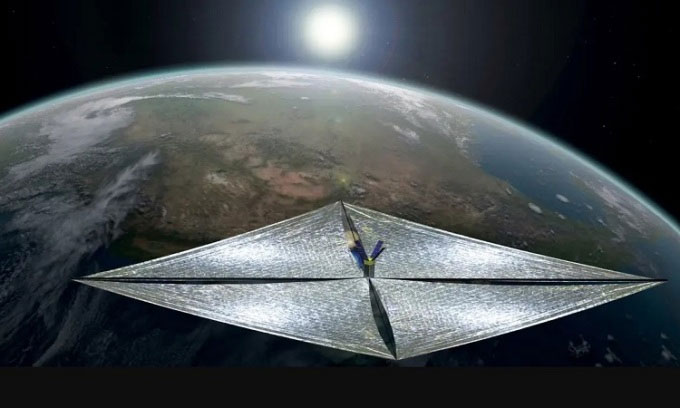Solar sails help spacecraft reach Mars in 26 days
A team of scientists simulated a trip to Mars and interstellar space using a solar sail made from aerographite with impressive results.
A team of scientists is looking into the potential of using aerographite to make solar sails that could travel to Mars and beyond, Interesting Engineering reported on September 27. The solar sail was first tested in space by the non-profit Planetary Society's LightSail 2 mission , which raised the orbit of a small CubeSat satellite by 2 miles (3.2 km), using only the propulsion of photons, or beams of light from the Sun. The study, published in the journal Acta Astronautica, details how scientists simulated a flight to Mars and interstellar space using aerographite solar sails.

Simulation of the solar sail of LightSail 2. (Photo: Planetary Society).
In the study, the team behind the project simulated the speed of a solar sail made from aerographite. They simulated a solar sail spacecraft with a mass of one kilogram, consisting of 720 grams of aerographite, and a cross-sectional area of 104 square meters. They measured the speed at which the solar sail could reach Mars and interstellar space, known as the heliopause, the point at which the influence of the solar wind is no longer felt. The researchers simulated two different routes from Earth, called the direct outward transition and the inward transition, for each flight.
The direct outward transfer method for a trip to Mars and the heliosphere boundary involves deploying a solar sail and launching from a polar orbit around the Earth. For the inward transfer method, the solar sail spacecraft would be carried by a conventional rocket to a distance of 0.6 astronomical units (AU) from the Sun. The solar sail would then unfold and begin its journey to Mars or the interstellar boundary.
The team found that the direct outward transition method would allow the solar sail spacecraft to reach Mars in 26 days . A spacecraft using the inward transition method would reach the red planet in 126 days . For the journey to the heliosphere, the inward transition method would take 5.3 years while the outward transition method would take 4.2 years. The outward transition method requires 103 days of travel before deployment, but reaches the heliosphere faster due to the fact that the solar sail reaches its maximum speed in 300 days. Using the outward transition method, it would take two years to reach its maximum speed.
Much of the reason the solar sail in the scientists' simulation can reach remote locations at high speeds is because of the material aerographite . With a low density of 0.18 kg/m3, aerographite outperforms all conventional solar sail materials, said team leader Julius Karlapp, a research assistant at Dresden University of Technology.
"For example, compared to Mylar, the density is many times lower. Assuming that the thrust of a solar sail depends directly on the mass of the sail, the result is a much higher thrust. In addition to the acceleration advantage, the mechanical properties of aerographite are very interesting ," says Karlapp.
Despite their high speeds, solar sails can only carry very small payloads to Mars or deep space. The Breakthrough Starshot mission, for example, hopes to send ultralight cameras to the nearest star system, Alpha Centauri, within 20 years.
- Solar sails help spacecraft fly without fuel
- Indian spacecraft coming to Mars
- Spacecraft can fly forever without fuel thanks to this
- Go to Mars within 3 days
- The sun changes, Mars is easier to live than Earth?
- NASA tested the new proton engine system for spacecraft
- Successfully launched the solar probe
- Nasa announced its willingness to launch a spacecraft to reach the Sun on Saturday
- The UAE is about to launch a spacecraft to Mars
- The spacecraft operates with water
- Mars travelers must use feces to cover the spacecraft
- Shorten the flight time to Mars to 38 days
 Van Allen's belt and evidence that the Apollo 11 mission to the Moon was myth
Van Allen's belt and evidence that the Apollo 11 mission to the Moon was myth The levels of civilization in the universe (Kardashev scale)
The levels of civilization in the universe (Kardashev scale) Today Mars, the sun and the Earth are aligned
Today Mars, the sun and the Earth are aligned The Amazon owner announced a secret plan to build a space base for thousands of people
The Amazon owner announced a secret plan to build a space base for thousands of people Which planet is the largest in the Solar System?
Which planet is the largest in the Solar System?  The Sun goes into hibernation, will the Earth usher in a new ice age?
The Sun goes into hibernation, will the Earth usher in a new ice age?  263 extrasolar objects discovered, hinting at a mysterious belt outside the Kuiper Belt
263 extrasolar objects discovered, hinting at a mysterious belt outside the Kuiper Belt  Does the Solar System have 5 more planets similar to Earth?
Does the Solar System have 5 more planets similar to Earth?  Superstructure in space 'shades' Earth
Superstructure in space 'shades' Earth  US successfully transmits solar power from space to Earth
US successfully transmits solar power from space to Earth 